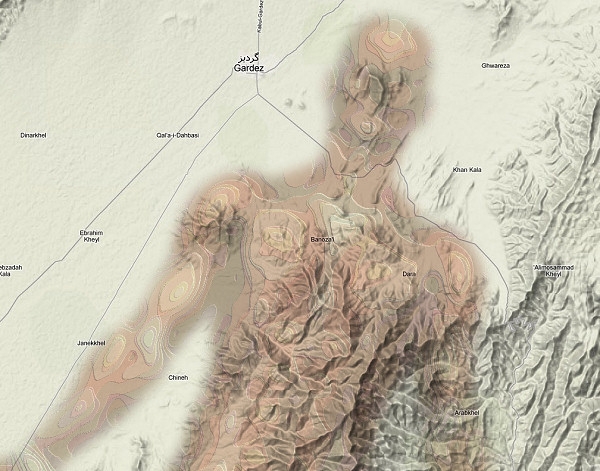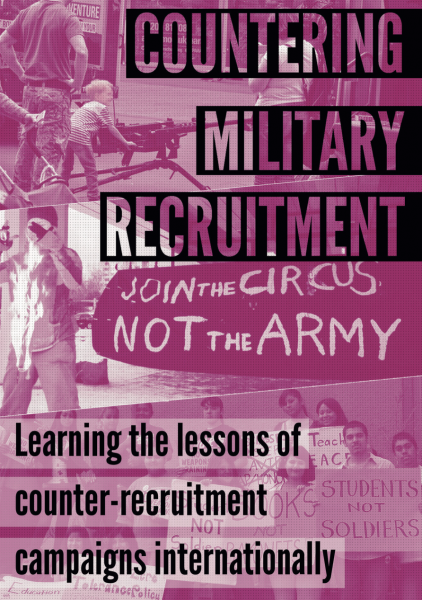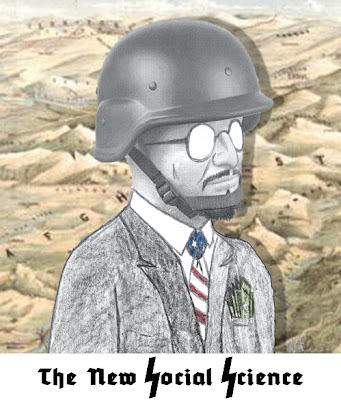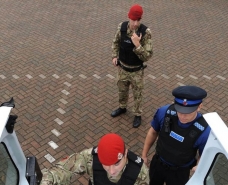Militarized Academia, Human Terrain System: article

Various -
The following is a list of articles and key extracts that deal specifically with the U.S. Army's Human Terrain System, and more broadly with "human terrain" applications of social sciences to military missions. The larger phenomenon of interest to AJP has to do with the militarization of academia. Emphases in bold have been added.
The reports cover areas that include news that a social scientist in Human Terrain Analysis assisted in interrogations, as may have one belonging to the Human Terrain System, even while the program officially insisted it was not involved with "intelligence" gathering; related to the last point, we also learn about Eric Rotzoll, former CIA, also involved with HTS; we learn about the further development of human terrain mapping technologies; in addition we read about the use of HTS data that is uploaded to databases which are then used to create extensive, detailed simulations of actual Afghan villages; we have more notes on military funding for university research aligned with national security goals, and counterinsurgency; we catch glimpses of retired military professionals joining the private sector, and boasting in part about their "human terrain" expertise; we see more discussion on anthropology as a "useful" and "practical" discipline to the powerful; and, lastly, a few funny and even bizarre videos about the Human Terrain System.
NEWS REPORTS
Counterinsurgency Adviser to Speak at VMI
Dec. 5, 2011
Dr. Martin Scott Catino, a counterinsurgency adviser and specialist in U.S. foreign and security policy, will speak at Virginia Military Institute Wednesday, Dec. 7. The talk, “Counterinsurgency and Culture: A Report from Afghanistan,”....Currently a counterinsurgency adviser for DevelopMental Labs Inc., Catino has served in the United States, Iraq, and Afghanistan in intelligence, supervisory, and advising posts for the U.S. government. In 2009-2010, during Operation Iraqi Freedom, he served as the deputy team leader and lead social scientist of the Human Terrain Analysis Team at Multi-National Division-South, Basra, Iraq. This past year, in Operation Enduring Freedom, he worked as the acting senior intelligence officer for a Defense Intelligence Agency unit at Camp Julien, Kabul, Afghanistan. This past spring he was embedded with a platoon of the 34th Infantry Division conducting operations in Kabul province.
CSTs face combat to ‘give Afghan women a voice’: Danger often lurks for female Cultural Support Teams
Army Times, Friday Dec 2, 2011
By John Ryan
...a new program that selects and trains female soldiers to embed with special operations teams across Afghanistan to cultivate relationships with local women and children, who make up about 70 percent of the population....The program is designed to assist counterinsurgency operations by tapping into a reservoir of female voices that have largely gone unheard because of local customs that frown upon American men and Afghan women interacting....Baldwin assessed schools and health clinics, facilitated meetings between village elders and nongovernmental organizations and participated in three women’s shuras From those meetings, she discovered many women wanted to learn how to read and write or sew. She was able to map “the human terrain,” like piecing together family trees, from her interactions with the Afghan women.
Defunct War Strategy Program May Still Overshadow University of Wisconsin-Madison's History of Dissent
Truthout, November 29, 2011
By Steve Horn and Allen Ruff
...Eric Rotzoll, a military man with intelligence community connections. As a deputy commander of a "provincial reconstruction team" (PRT) in Zabul Province, Afghanistan in 2004 and 2005, he planned and led civil affairs operations in support of counterinsurgency in the region. From 2006 to 2010, he worked as an "all source analyst" for Defense Department intelligence subcontractor Northrop Grumman. Still with the military at that time, he also served from July 2008 to July 2009 as a Human Terrain Team (HTT) leader in Afghanistan. The HTTs, ostensibly comprising privately contracted civilian anthropologists and other social scientists, have been assigned to each Army brigade in Iraq and Afghanistan since late 2005. Armed on patrol, such "academic embeds" have worked to provide cultural and social "human intelligence," or "Humint," on various "locals" as part of the counterinsurgency effort in both countries. In January, 2009, an embedded journalist moving with an HTT unit on the ground in Afghanistan identified Rotzoll as "the man in charge" and "a former analyst for the CIA...." No mere enlisted man, but an academically trained intelligence warrior, Rotzoll apparently brought a particular added expertise to the "Grand Strategy Workshop." His name also subsequently appeared on the UW JASONs roster for 2009-2010, his affiliation listed simply as "US Army."
Afghanistan: What the Anthropologists Say
The New York Times, November 18, 2011
By Alexander Star
As in Iraq, the United States military has responded to bad news with counterinsurgency: eliminate troublemakers in the dark of night, with the most lethal arts, and befriend tribal elders by day, with cultural sensitivity and expertise. The Army has gone so far as to embed credentialed social scientists with front-line troops in “Human Terrain Teams” that engage in “rapid ethnographic assessment” — conducting interviews and administering surveys, learning about land disputes, social networks and how to “operationalize” the Pashtun tribal code. The military, in short, demands local knowledge. But what kind of local knowledge is in supply, and what does it indicate? Though the chief purveyors of such insight, academic ethnographers, have balked at working with the military — the American Anthropological Association issued a report condemning the Human Terrain program as a violation of professional ethics — they have not ignored the country.
Morgan State wins $1.8M grant to start national security program
Monday, November 14, 2011
Alexander Jackson - Baltimore Business Journal
Morgan State University has been selected to receive a five-year, $1.8 million federal grant to begin a degree program in national security. The Office of the Director of National Intelligence's Intelligence Community Centers of Academic Excellence Program chose Morgan and the University of South Florida to be awarded with grants to establish programs in National Security Studies. The National Security Studies program will be aimed at honing skills needed in the intelligence community such as international relations, foreign language and cultural immersion, scientific and technical programs of study, including cyber security....Under its five-year grant deal, Morgan will establish a consortium of historically black schools in Maryland, Virginia and North Carolina to do research in human terrain systems and bio-systems with specific applications to South Asian countries such as Afghanistan, India, Bangladesh, Nepal and Pakistan. The National Security Studies Program was established during 2005 in response to the nation's increasing need for professionals in the intelligence community who are educated and trained with the unique knowledge, skills and capabilities to carry out America's national security objectives.
For decades, the Army's Aviation and Missile Command, Space and Missile Defense Command, NASA, and other institutions have turned to UAH [University of Alabama, Hunstville] in the search for solutions to complex technical issues. But Horack [Dr. John Horack, UAH Vice President for Research] thinks there is an element they're missing. The Department of Defense, he says, is "transforming in ways that aren't fully predictable," facing new threats in a highly-charged political environment and constrained budget situation. And while the military has always looked to America's universities for help in solving complex technical issues, Horack thinks they should also look for help with what he terms "the human terrain." University faculty, he says, can take a fresh look at problems and issues, and bring insights and perspectives to problems facing America's military planners. "There is a need for improved socio-economic awareness. But there is no place to go on the GSA schedule to get this type of information." The military, he says, have underutilized America's universities, failing to get from them vital information that could aid strategy and operations in missions around the globe. "We're not using university muscle as well as we could," he says.
Interrogation is not a social science
Financial Times, November 4, 2011
By Gillian Tett
....when the anthropology “tribe” assembles this year, it will have a new topic to discuss: its links with “power” – or, at least, the US military. Last month, the AAA posted an article from Nature on its website that claimed that the US military has been employing the services of anthropologists in Afghanistan to improve its data-gathering techniques. In particular, during the past five years, it has apparently run so-called “human terrain analysis” programmes, to make its Afghan operations more culturally sensitive....But what has made this latest revelation so controversial is that Julia Bowers, the anthropologist named by Nature, was not just writing tomes about Afghan marriage rituals, she was aiding interrogations too. Or as Nature reported her telling a conference: “Typically human-terrain analysis is more of a human data-gathering and mapping approach…” but cultural expertise was “key in the support I was providing to the interrogator to develop a relationship with the detainee”. While, crucially, it is unclear how widespread this practice might be, the revelation has reawakened the debate about just how far social scientists should allow themselves to aid the elite....“Advising people on how to extract information from people who don’t want information extracted, that is the antithesis of what the anthropological encounter is supposed to look like,” Hugh Gusterson, a network leader, has observed. But the pressures will not die away soon; not when budgets are being cut, jobs are scarce and governments (and corporations) are desperate to get better information about culture. To put it another way, precisely because anthropologists are good at analysing cultures and power structures, their research is of interest to people in… er… power. It is a bitter irony; even – or especially – in Afghanistan.
Neah Appoints Colonel Lamont Woody as Defense Advisor to the Board of Directors
Market Watch, October 26, 2011
NEAH Power Systems, Inc. announced today it has appointed Col. Lamont Woody, US Army (Retired), most recently a principal of the Laconia Group, as its defense advisor to its Board of Directors. In this role, Col. Woody will advise the company in international defense and government relations and various potential collaboration, partnership and business development opportunities....Col. Woody [in his military career] also implemented human terrain, social networking systems, and law enforcement systems and programs.
Strategic Paradigms » Blog Archive Perspectives on the C4ISR Conference – October 2011
October 28, 2011
By Ehsan Arari
Even the panel on the Human Terrain System (HTS) – a topic of great interest and personal involvement for me – was too tactical in its focus....My own take as an outsider (i.e., a person who does not tow any party line) is that our Achilles heel related to intelligence is the ever-growing complexity of our Intel bureaucracy and the mountainous nature of Intel data. We collect a lot, but have no clue as to what to do with it. I heard the evidence of that during the panel on HTS.
GEOINT 2011 summary | Open Geography
October 24, 2011
The panel (video link) speculated on socio-cultural intelligence as a new facet of intelligence, ie SOCINT. Sharon Hamilton provided a lot of information about the HTS (now over 40 in total, with 31 teams in Afghanistan). It has now been given permanent funding (rather than through Supplementals). She said they use the NGA 12 human geography standards of data to make a baseline dataset (video 1:49’50″), and that 55% of their products are unclassified at the moment. Hamilton claimed that HTS does not have to “convince” the social science community (of the value of HTS) because they (the Army) fill their HTS classes (video at 1:34’00″). You can take that statement with a pinch of salt, no doubt.
New Mission for Military’s ‘Human Terrain’ Experts: Interrogation
Wired, October 19, 2011
By Sharon Weinberger
Cultural expertise was “key in the support I was providing to the interrogator to develop a relationship with the detainee”, said Julia Bowers, principal senior analyst for human terrain at SCIA, a company based in Tampa, Florida, that provides socio-cultural services for the military and intelligence community....Bowers worked with the U.S. Central Command’s human terrain analysis branch, which is separate from the Army’s Human Terrain System (HTS), a better known program that embeds social scientists in combat units. Both, however, are designed to provide the military with better cultural understanding and expertise....The interesting question is whether anyone associated with the HTS, which has been dogged with controversy over its five year existence, has been involved with interrogations. An internal memo — dated March 16, 2009 and signed by then-HTS program manager retired Col. Steve Fondacaro — notes that “HTS does not have DoD [Department of Defense] approval to conduct interrogation operations.” “HTS personnel are not trained and certified in interrogation methodology and as a result will not conduct interrogations,” the memo continues. Nevertheless, one former employee me that this is precisely what appears to have happened in 2009; but when the employee complained to the program’s senior leadership, they did nothing. When asked about this, Fondacaro replied in an email that “all the units we supported ran interrogations, just like they ran mess halls, vehicle maintenance, medical support ops, civil affairs etc. and HTS supported the unit.”....“Our team members may have been asked to help or advise in any or all of these areas where it related to greater insight and understanding of the population,” he told Nature. “But it did not result in any of these operation becoming core mission capabilities HTS focused upon.”
Pentagon Cultural Analyst Helped Interrogate Detainees in Afghanistan: 'Experiment' raises alarm among social scientists.
Scientific American, October 18, 2011
By Sharon Weinberger of Nature magazine
So far, the HTS has been involved in interrogations in just one experiment. A former employee of the HTS, who asked not to be identified, says that they learned in 2009 that HTS personnel were involved at one point in interrogations in Afghanistan. "I sent it up the chain at Fort Leavenworth; they knew about it," the employee says. "It struck me as blatantly unethical. I didn't want anything to with it." The employee, who describes the work as "the exact opposite of what the program says it is", left the HTS shortly after voicing their concerns. Retired Army Col. Steve Fondacaro, who headed HTS until he was ousted in a management shakeup last year notes that all the units that HTS teams support are involved in interrogations.
First They Came for the Anthropologists
The Atlantic, October 12, 2011
By Edward Tenner
The real irony of Governor Scott's remarks [about anthropology being an impractical degree area that is not useful for finding employment] is that anthropology can be so practical that it even makes many anthropologists uneasy, as in the Defense Department's Human Terrain Program, condemned as unethical by a commission of the American Anthropological Association (AAA) in 2009.
ISEBOX Fuses Geospatial Data: New Methods of Human Terrain Analysis
Imaging Notes Magazine, Fall 2011, Volume 26 Number 4
By By Abe Usher, CTO and Altaf Bahora, Vice President The HumanGeo Group
To enable the military to fuse together the data at its disposal and make better decisions, faster, the HumanGeo Group developed ISEBOX (Integrated Socio-Cultural Environment for Behavior Observation Exploitation), a geospatial threat-forecasting application that allows data with different spatial resolutions to be intermixed while preserving the original data. ISEBOX identifies friendly forces, trends, geo-political activity, and threat indicators to provide operations planners with critical access to data required to perform Intelligence Preparation of the Battlefield (IPB). ISEBOX uses variable precision data encodings of location to facilitate non-obvious pattern detection and predictive analysis in the geospatial domain....ISEBOX ingests the widest range of open sources of geospatial data (such as social media, civilian government sources, NGO data, and community-driven data collections) and provides a means of combining the sources to enable analysts to detect non-obvious patterns in the data in order to “tip and cue” planners, collectors, and analysts to points on the ground defined by geography, time, function, and analytic discipline.
Knowing the enemy, one avatar at a time: As military crafts virtual Afghan villages, some scientists raise ethical concerns
The Boston Globe, May 30, 2010
By Farah Stockman
The villagers are bits of software code, and the Americans who “visit’’ are players in a videogame-like program designed not only for training purposes but for intelligence analysis. The program, which loosely resembles the game SimCity, is part of a US government effort to develop sophisticated computer models of real Afghan villages — complete with virtual people based on actual inhabitants — in an attempt to predict their reaction to US raids and humanitarian aid. The project, spearheaded by a University of Pennsylvania engineer at the behest of an undisclosed US government agency, straddles the line between research and intelligence as part of a wider US effort to design software capable of forecasting human behavior in war zones. This type of research, often referred to as “human terrain mapping,’’ has attracted increased funding in recent years from US military planners who believe it will become a crucial tool for combating terrorism and insurgencies....“Are we going to detain someone if a computer predicts that he will become an insurgent?’’ asked Hugh Gusterson, an anthropologist at George Mason University. “The real danger of models is their seductiveness. They can be so realistic and powerful that it is easy to forget they are just a model, and they start to rely on them more and more.’’ The concerns were so great that the US Department of Energy, which controls the national laboratories that own some of the most sophisticated computers in the country, has pushed back against recent efforts to enlist its scientists in the work. Citing uncertainty about how the military will use this research, Energy Secretary Steven Chu issued a memo late last year barring employees from working with data about individuals, citing fears that it could violate a federal law mandating that human research subjects never be harmed. “The lack of full disclosure of the purpose and the potential repercussions to subjects recruited for participation . . . undermines any . . . ability to review such work against federal requirements for the protection of human research volunteers,’’ Chu wrote in December. The project also adds fuel to an ongoing debate over whether social scientists should ply their trade for the military, since some virtual villages are created using surveys taken by embedded social scientists known as human terrain teams....Silverman believes that one day, the whole of southern Afghanistan will be recreated in a vast computer model....Shortly after the human terrain teams were launched in 2005, the Marines paid Silverman to study what could be done with data they had collected. He published a paper arguing that it should be fed into simulators to help forecast events. Since then, the human terrain teams have shifted their data collection methods from open-ended reports toward more rigid questionnaires that can easily be uploaded into a database, according to former terrain team members. John Allison, an anthropologist who began training as a team member last November but has since resigned, said the teams were taught to upload the data into a classified Pentagon database known as SIPRNet, where is it distributed to a host of US agencies, some of whom pass it on to analysts like Silverman. Steve Fondacaro, the project manager for the Army’s human terrain system that oversees the data-collection teams, said the information is primarily used by commanders on the ground to design effective development projects. He said the data are not used to harm anyone. But he also acknowledged that he does not know what other agencies do with the information. “I don’t spend a lot of time tracking down what the government people are doing with the data that we access on the ground,’’ he said, adding that he did not know about Silverman’s project.
Countering Military Recruitment

WRI's new booklet, Countering Military Recruitment: Learning the lessons of counter-recruitment campaigns internationally, is out now. The booklet includes examples of campaigning against youth militarisation across different countries with the contribution of grassroot activists.
You can order a paperback version here.









